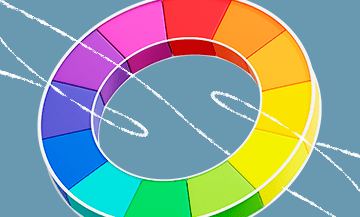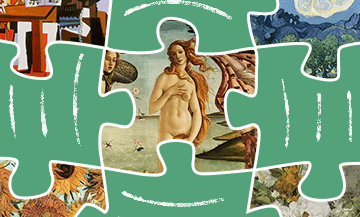The universe is rich in various forms of expression, and among them, one of the most mesmerizing and soothing is landscape painting. This genre of art has undergone many changes over time, imbued with the boundless beauty and grandeur of nature.
I invite you to embark on a journey through time and space to delve into the world of landscape painting.
Landscape in drawing, painting and art
From the very beginning of human history, landscapes have been our steadfast companions. Ancient drawings on cave walls depicted animals and events worthy of the attention of hunters and artists. These primitive drawings were the first steps in the art of landscape painting.
With the development of society and technology, landscape painting began to flourish. It came to reflect not only the physical world but also the spiritual and emotional states of artists. During the Renaissance, great masters such as Leonardo da Vinci and Raphael contributed to the development of landscape art, creating works that still captivate with their beauty and depth.
Over time, landscape painting became a distinct genre of art with its own rules and traditions. It branched out into many sub-genres, each offering a unique perspective on the natural world. Rural landscapes convey the serene beauty of the countryside, urban landscapes capture the hustle and rhythm of modern life, while seascapes encompass the boundless expanses of the ocean.


A landscape can be historical, mythological, romantic, or even abstract. It changes with the seasons, reflecting the beauty of each time of year. The techniques and materials used in landscape painting are also diverse. Artists create their works using oil paints, watercolors, pastels, and more.
Famous masters such as Claude Monet, Vincent van Gogh, and John Constable have left behind true masterpieces of landscape painting. Their works remain relevant and continue to inspire us.
History of the emergence and development of landscape painting
Landscape painting, as an independent genre, began its development in the 17th century in the Netherlands. At that time, it had not yet achieved the popularity it enjoys today, with portraits and religious subjects occupying a much larger place in the cultural life of people.
However, this changed when humanity developed an interest in exploring its relationship with nature, comparing the richness of the inner world with the outer world.
Great masters such as Rembrandt and Van Gogh made the greatest contributions to the development of landscape painting, leaving us with artworks that enrich our souls and literally transport us to other worlds.
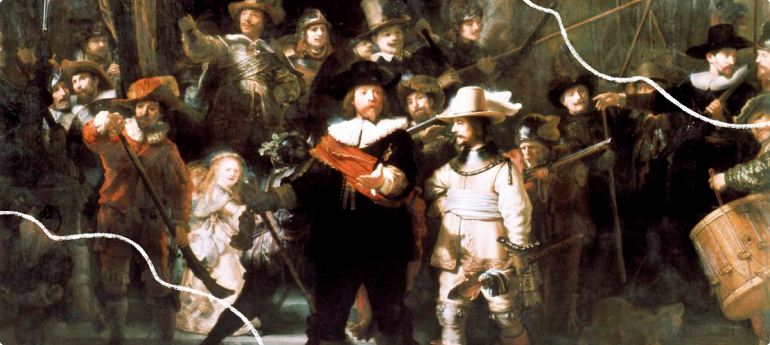
Subgenres of landscape painting
Landscape painting invites us to stroll through the boundless expanses of nature. Its magic lies in its ability to inspire and make us ponder.
And that’s not all…
Landscape painting is rich in subgenres. I suggest getting to know them better and discovering how artists create their amazing landscapes with brushstrokes.
Natural landscape
Natural landscape is an ode to the beauty of nature in its natural form. Here, artists strive to capture majestic mountain ranges, picturesque valleys, gloomy forests, and snow-covered plateaus.
Creators seize the moment when nature reveals itself to us in all its grandeur.
Paintings of natural landscapes help to forget everyday worries and immerse oneself in a world of serene harmony — that is why they have gained the greatest fame and love.


Rural landscape
Under the coat of silence and tranquility, the rural landscape unfolds before us like the page of an old book, full of nostalgia and grace. The rural landscape is a window into country life. A world where time flows slowly, and nature is an integral part of this life. Rural views take us to distant village realms, where simplicity and beauty can be found in every corner.
Paintings of rural fields, pastoral scenes, and farm life — each work of the artist seems to tell us a story. We return to our roots, appreciate the simplicity of country life, and regain our inner peace.
How easy it is to enjoy art in the sparkle of dew drops on the grass, in the vibrant colors of the fields, and in the silence broken only by the songs of birds.
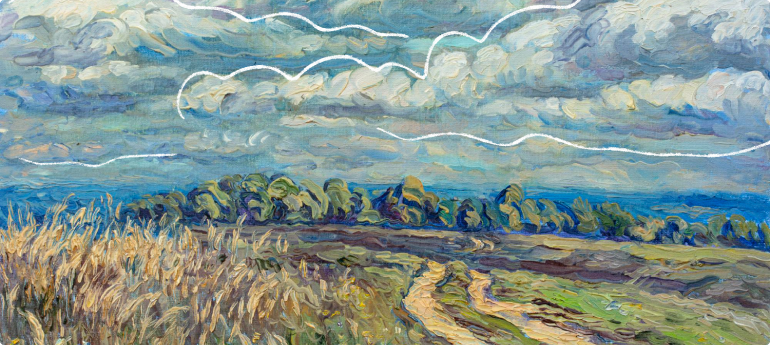
Cityscape
As we stroll through the city streets, our eyes are drawn to the variety of shapes and colors: majestic skyscrapers, historic buildings with rich histories, numerous cars speeding by, densely overgrown squares where trees and flowers delight the eye with their beauty. The city lights at night create a magical atmosphere, like constellations descending to the earth.
This is what cityscape paintings try to convey to us.
In a cityscape, you can find many interesting details and unexpected scenes. In the city streets, real life unfolds: people meet and part, interact, and take care of their affairs. The city is a vast stage where each of us plays our role.
On the canvas, every building, every street, and even every lamppost comes to life. Golden reflections of the sun on windows and reflections in water create magical effects that only oil paint can so skillfully capture.
Thus, a cityscape under the artist’s brush becomes a bridge between reality and imagination — a place where the magic of art meets the vibrant pulse of the city.


Seascape
At first glance, the sea’s surface may seem calm and uniform, but a closer look reveals its true nature.
Sunbeams caress the water’s surface, making it sparkle like millions of diamonds flashing in the dance of the tides. The sea breeze brings the scent of freshness and freedom, while the rising waves are the sounds of nature, reminding us of the eternal passage of time.
The seascape has a remarkable ability to both soothe and inspire — and that’s why we love it.
Artists draw inspiration from the sea, striving to capture its beauty and power on their canvases. They play with shades of blue and green, depicting the depth and movement of the water. Their brushes recreate the splashes of waves and the play of light on the water’s surface.
The sea can be calm and gentle, like the touch of the wind, or stormy and mighty — a sensual tremor before its boundless power.
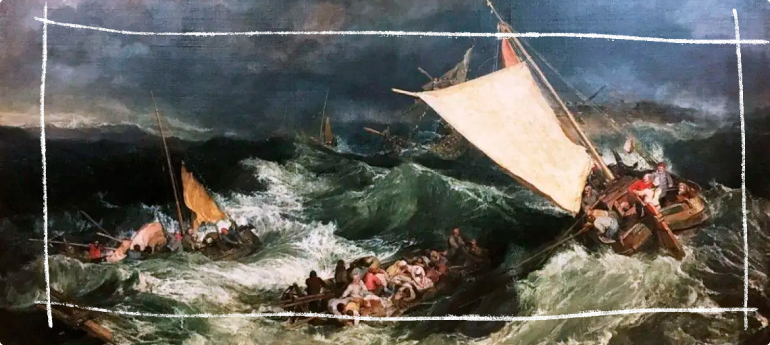
Space landscape
On artists’ canvases, incredible worlds unfold where the sky becomes a space for mystical colors and shapes. It’s as if magic transports us to the moment when the night sky comes alive with the brilliance of millions of stars, and galaxies drift through the boundless space.
Cosmic landscape painting not only depicts space but also allows us to immerse ourselves in the world of the mysteries and enigmas of the Universe. Each such work of art becomes a boundary between our reality and the world of dreams, a place where human imagination knows no bounds — space.
Artists seek ideas for their paintings from night skies, astronomical discoveries, and hypothetical journeys into the depths of space. They create paintings where the interplay of light and darkness creates astonishing drama. Each cosmic painting is an exploration of the harmony inherent in the entire Universe.
The cosmic landscape in painters’ works reminds us that even in our vast galaxy — we, ordinary people, occupy an important place and play our role.
Contemporary artists skillfully combine vibrant and rich colors with abstract forms in their works. Shades of blue, purple, and black are softened by velvety hues and smooth transitions, giving the paintings a cosmic character and elegance. Cosmic themes are very popular today, and many seek to adorn their walls with them.


Types of landscapes according to the plot: historical, mythological, fairy/fantasy, romantic and abstract
Painting has always served as a mirror reflecting the surrounding world. A wonderful way to convey the beauty and power of nature is to create a landscape on canvas. However, despite the common theme, artists have developed various types of landscapes over the centuries to more deeply convey their feelings and ideas.
 Historical Landscape:
Historical Landscape:
Historical landscape painting is the magic of time and colors embodied on canvas by great artists. It is a window into the past, allowing us to feel the spirit and emotions of eras that remain in the world’s memory.
Painters skillfully convey the atmosphere of ancient cities, castles, and landscapes, transporting us to moments of events that changed the course of history. These paintings teach us to value history, understand its depth, and its impact on our society. They also inspire contemporaries to new achievements and discoveries. Mythological Landscape:
Mythological Landscape:
A gateway to a world of eternal stories, where gods and heroes continue to live. On canvas or in watercolor, the mythological landscape turns into an enchanting world filled with a mystical atmosphere.
Somewhere in the distance, gods rise against the horizon, their figures stretching into the sky, symbolizing grandeur and power. Somewhere in the forest or at the foot of the mountains, magical gardens bloom, and wonderful creatures meet, their secrets artfully hidden from the viewer’s eyes.
Colors play an especially important role in creating a mythological landscape. The fire of red and orange, the water of blue and green, the sun of bright yellow — each shade transports us to different eras and worlds. Through the artist’s brush, the grandeur of ancient Olympian gods, the mystery of Norse myths, or the mystique of Slavic mythology penetrates.
 Fantasy Landscape:
Fantasy Landscape:
When looking at a fantasy landscape, you feel time standing still. Winds rustle in the branches of trees, like wise guardians of secret forests, and light purple clouds in the sky smoothly blend into different shades, like drops of magical dew. In the distance, among the thick foliage, mysterious beings, mythical creatures, hide from human eyes.
Fantasy landscapes are often inspired by history, legends, and myths, and they can reveal traces of ancient civilizations and lost kingdoms. Forgotten ruins and temples, covered in ivy and moss, become part of this magical picture.
Fantasy painting allows us to escape from the mundane and immerse ourselves in a world of magic and imagination, where anything is possible. It invites us to dream, seek adventures, and believe in magic.
 Romantic Landscape:
Romantic Landscape:
In romantic landscapes, nature plays the main role. It becomes a true heroine with its own emotions and soul.
A special place is given to the sky. It can be stormy and imposing or gentle and covered with pink hues of sunset. Clouds dance in the boundless expanse, creating harmony with nature.
The sun, shining through the clouds, illuminates the world with bright glints of light, as if hinting at the endless possibilities and mysteries of life. In such paintings, we see snow-covered mountain peaks touching the sky and rivers flowing into infinite distances.
A romantic landscape in painting is not just a depiction of nature; it is the art of transferring one’s emotions, dreams, and feelings onto the canvas. It reminds us that the world around us is rich and multifaceted, and sometimes we just need to stop and enjoy this beauty.
 Abstract Landscape:
Abstract Landscape:
In abstract landscapes, colors dance on the canvas like a whirlwind of emotions and inspiration. They create a mood: sometimes calm and serene, and sometimes explosive and dynamic.
Abstract landscapes can be mystical morning mists or bright sunsets, winter forests at twilight or picturesque sea horizons.
They lack clear contours and distinct forms, but they offer the opportunity to see and feel something personal, to imbue it with one’s own emotions and interpretations.
If abstract painting could be described in just two words, they would definitely be — freedom and creativity.
Types of landscapes by time of year
Nature is an endless artist, constantly changing its attire and offering delightful landscapes. Each season of the year hides its unique beauty, and each brings its own distinct charm to painting.
 Spring
Spring
The time of nature’s awakening after a long winter. Artists often depict the vibrant colors of trees and flowers, sparkling streams, and meadows where warm-loving animals graze. Spring landscapes are filled with bright hope and joy, giving us a sense of something new that is about to happen.
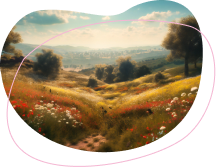 Summer
Summer
A moment of abundance and life. Creators paint the bright sun, lush tree foliage, and the blue waters of lakes and rivers. Summer landscapes are full of energy and warmth, their beauty makes us feel alive and free.
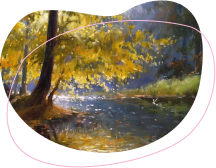 Autumn
Autumn
A time of tranquility and solitude. Painters skillfully convey the palette of autumn colors: from golden and red leaves to gray, rainy days. Autumn landscapes evoke a sense of melancholy and nostalgia, calling us to reflect on the transience of life.
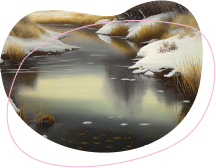 Winter
Winter
A moment of fairy tales and magic. Here, you find snow blankets, sparkling snowdrifts, frozen lakes, and fluffy snowflakes. Winter landscapes impart a sense of calm and purity; looking at such paintings, we recall childhood and forget all our worries.
Each season offers the opportunity to see our world in a new light. It’s no wonder that the seasons of the year are a wonderful source of inspiration for all creative people.
Landscape painting tools, materials and techniques

Oil Paints: are one of the most popular choices among landscape painters. They offer vibrant colors and dry slowly, allowing for rich and deep hues.

Acrylic Paints: dry quickly and also have bright colors. They are suitable for when a landscape needs to be painted quickly — for example, outdoors.

Watercolors: watercolor and gouache paints are ideal for creating delicate and transparent landscapes. They are especially good for painting skies, water surfaces, and flora.

Canvas: artists can choose from various types of canvases depending on their preferences. Primed canvases, textured canvases, or paper are specifically designed for different painting techniques.

Brushes: from fine details to broad strokes — the choice of brushes depends on what you want to achieve on the canvas today.

Palette: a palette is the surface on which paints are mixed. It can be made of wood, plastic, or glass.

Thinners and Mixing Mediums: thinners and mixing mediums are used to alter the consistency and viscosity of paints, which helps in creating various textures and effects.
Techniques
- Main Plan: this technique involves determining the main elements of the landscape and arranging them in the composition, starting with the main object and gradually adding details.
- Use of Color and Light: color and lighting play an important role in landscape painting. It is essential for artists to consider the lighting, time of day, and weather conditions to convey the desired atmosphere and mood on their canvas.
- Application Technique: depending on the chosen material, artists may apply paints in different ways — with strokes, dabs, or wet-on-wet methods.
- Creating Texture: to convey various textures — such as foliage, water, or stones, painters use different techniques, including hatching, sponges, knives, and other tools.
Landscape painting is an art that requires a good understanding of nature, the ability to observe closely, and skill in handling tools and materials.
Famous masters and works in the landscape genre




Landscape in contemporary art
Today’s masters of painting do not limit themselves to traditional notions of landscape. They play with colors, shapes, and textures, evoking emotions and associations in viewers that go far beyond a simple depiction of nature.
A modern landscape can be abstract, symbolic, or fantastical — there are no limitations or boundaries. It is not just an image of mountains, fields, and waterfalls. It is a reflection of the artist’s soul, their relationship with the environment, dreams, and hopes.
Finally, landscape art invites us to reflect on our role in the world and our relationship with the environment. So let us pause and immerse ourselves in the beauty and mystery of nature and the human soul.
Question-answer
Landscape painting is a window into the world of nature, kindly opened for us by the artist. It is the magic of colors, shapes, and light that allows us to see and feel a piece of nature captured on canvas.
It is the art of conveying emotions, mood, and the beauty of the world around us, like music but created with a brush and oil. Landscapes hold a magic capable of transporting us to another space where the sound of a waterfall, the light of a sunset, and the inspiration of nature become our reality on the canvas.
A landscape is not only a depiction of the surrounding nature but also an expression of the artist’s emotions and mood. In a landscape, the play of light and color, along with many other details symbolizing the artist’s theme or idea, is often skillfully conveyed.
Landscape painting allows us to see the world through the creator’s eyes and feel their inner world.
There are many subgenres in landscape painting. For example, mountain landscapes with majestic peaks, seascapes with endless waves, forest landscapes with numerous trees and animals, desert landscapes with golden dunes, and, of course, cityscapes with modern skyscrapers.
In the world of nature and painting, there is a place for every type of landscape, and each one has its own unique beauty.
Nature has always inspired artists with its multifaceted beauty. The natural world offers an endless variety of forms, colors, and textures, which attracts creators and motivates them to pick up a brush.
It is impossible not to admire nature painting. There is a desire to immortalize those natural moments that are so fleeting in our lives. Paintings preserve the beauty of the moment, and artists strive to convey this connection in their works.
In the 19th century, Russian artists began to take an interest in landscapes, inspired by Western masters and romantic ideas about nature. They traveled, studied nature, and painted their first landscapes.
Crimean landscapes became a fertile ground for Russian artists. Russian painter Ivan Aivazovsky explored the Black Sea coast and skillfully captured its grandeur and beauty.
Very soon, landscapes became a symbol of national identity, and artists strove to convey the spirit and beauty of Russia in their works. Ivan Shishkin and Alexei Savrasov are prominent representatives of this era.
At the beginning of the 20th century, the Russian landscape school experienced a period of emancipation, when artists freed themselves from academic canons and began experimenting with form and color. This opened the doors to modernism and abstraction in painting.
During the Renaissance, artists began to closely study nature, and landscapes were an important part of their work. Leonardo da Vinci and Albrecht Dürer created early masterpieces of landscape painting.
The Romantic era marked a growth in interest in landscapes as a means of expressing emotions and feelings. Artist Caspar David Friedrich created landscapes that evoke a sense of sublimity and absolute admiration for nature.
Impressionists Claude Monet and Pierre-Auguste Renoir began to capture moments and light effects in their paintings. They used bright colors and short strokes to capture the transience of nature and light reflections.
In the 20th century, landscape art underwent radical changes. Wassily Kandinsky and Pablo Picasso experimented with abstract forms and symbols.
In contemporary art, the landscape school continues to evolve in various directions. Painters can work with traditional methods or use modern technologies, giving landscapes a completely new look.
The evolution of the European landscape school is a history full of passion, creativity, exploration of nature, and its impact on humans. Artists from different eras have left us an invaluable mark in the world of art.



